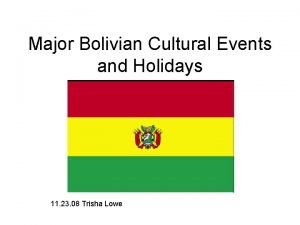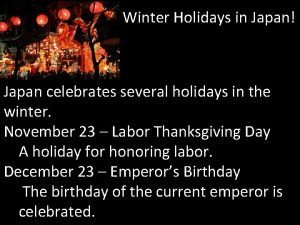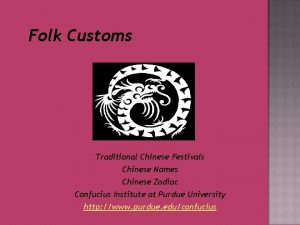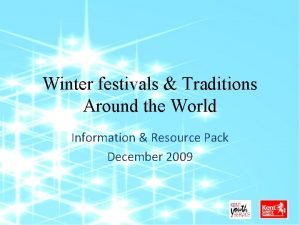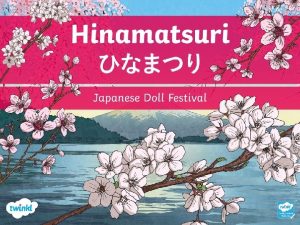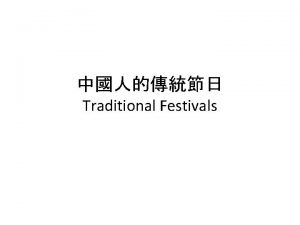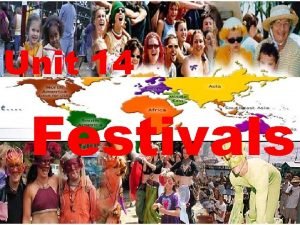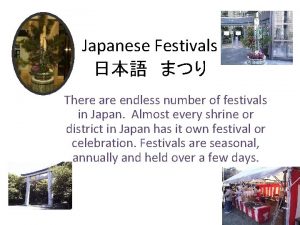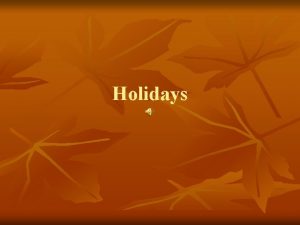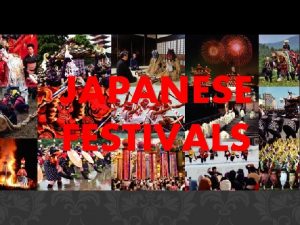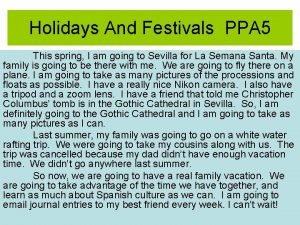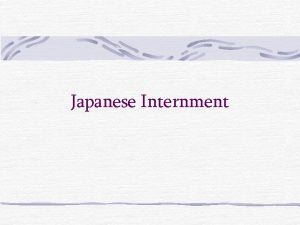Japanese festivals National Holidays Spring Hinamatsuri The girls

















- Slides: 17

Japanese festivals & National Holidays

Spring

Hinamatsuri (The girl’s Festival) The Girls’ Festival is a celebration for girls held on March 3 rd, during which the girls’ healthy and happy future is wished for. A family with a daughter decorates a room with special dolls called Hina Ningyo and places special offerings such as rice cakes called Hina Arare.

Hanami (Flower. Viewing) The Cherry blossom(Sakura) is Japan’s national flower. It is described as the ‘king of the flowers’ because of its breathtaking beauty. Many families and workers bring food and drink and have a hanami party under the cherry trees. They all enjoy seeing the beautiful cherry tree blossoms.

Children’s Day (The Boys’ Festival) May 5 th is Children’s Day, a national holiday to celebrate and wish children a happy life and future. It is also the day of the Boy’s Festival. A helmet called kabuto is displayed in the house. It is said that in the olden days a warrior’s Kabuto represented one’s heroism.

Summer

Yukata A Yukata is an informal style of kimono for the summer. For a summer festival, many people may wear the same yukatas, especially in Bon Dance and Fireworks. A pair of Geta sandals are the footwear to go with the yukata. A Sensu is a folding-type of fan and is handy to carry around and use to cool off.

Bon Dance A Bon Dance was originally performed to console the spirits of the deceased. Nowadays, it is performed as a leisurely summer event by all people. A raised platform is built in a school ground or open space. Many people dress in yukata and they dance around the platform to the music of flutes and the rhythm of drums.

Shoro. Nagashi (Lantern Floating) At the end of summer, as a means to send off the ancestral spirits that visited their offspring during the summer, small lanterns with lit candles and the items of offerings (e. g. flowers) are floated on rivers and seas. It is impressive to see all the small lights floating on a river at dusk. The Shoro. Nagashi is held in Nagasaki and Kyoto.

Nebuta Festival The Nebuta Festival is held in Aomori Prefecture, northern Japan, on August 1 st through 7 th. It is conducted prior to the fall harvest. In the past, it served as a ritualistic festival to ward off farmers’ sleepiness that would interfere with their work. Nebuta refer to a gigantic lantern, which is made of wooden or bamboo frames and paper. A big nebuta lantern can be more than 10 metres in height.

Autumn

Koyo ‘Koyo’ means the process of leaves changing their colours in the fall, as seen, for example, with maple leaves. You can enjoy Koyo even in the city. But if you really want to take good shots with your camera, you should go to nearby parks, rivers, or mountains. These pictures were taken at Kiyomizu Temple, one of the famous temples in Kyoto.

Shichi Go San (7 -5 -3) November 15 th is called the day of Shichi(seven) Go(five) San(three). It is the day to celebrate a child’s being able to safely reach these three ages. Today, on the day of Shichi Go San, children dress up and visit shrines with their parents. On their way back, they purchase red and white candies called chitoseame. The colours (red & white) are considered lucky.

The Danjiri Festival of Kishiwada The Danjiri Festival is held in Kishiwada town, Osaka on September 14 th and 15 th. It is a dangerous festival. Men run all around town pushing and pulling huge wooden floats called ‘Danjiri’. More than 10 floats participate in the festival and compete with each other while racing around. Injuries and damage to the houses along the streets are common problems.

Winter

Gantan (The New Year’s Day) Gantan (the New Year’s Day), which is January 1 st, is a national holiday. The phrase akemashite omedetou gozaimasu is a typical greeting exchanged during the new year. Many Japanese decorate front doors with a pair of ‘Kadomatsu’ and ‘Shimenawa’.

Hatsumode (New Year’s Visit to Shrine) During the first three days of the New Year, many Japanese people visit nearby shrines. It is called ‘Hatsumode’. People visiting the shrines pay respects to the gods and pray for the new year to be a blessed one with good health for the family, prosperity of business, and so on.
 British holidays and festivals
British holidays and festivals Bolivia holidays and festivals
Bolivia holidays and festivals Traditional holidays in italy
Traditional holidays in italy Winter holidays japan
Winter holidays japan Kim ki duk spring summer fall winter
Kim ki duk spring summer fall winter Winter spring summer autumn months
Winter spring summer autumn months National girls collaborative project
National girls collaborative project Festivals in english speaking countries
Festivals in english speaking countries Birthplace of theatre
Birthplace of theatre Agusan del sur festivals
Agusan del sur festivals Greek theatre festivals
Greek theatre festivals Saijaleena rantanen
Saijaleena rantanen Festivals
Festivals Greek theatre history
Greek theatre history Modern chinese names
Modern chinese names Russian winter festivals guide
Russian winter festivals guide Winter festivals around the world
Winter festivals around the world Swot analysis of festivals
Swot analysis of festivals

